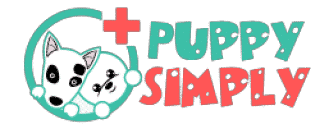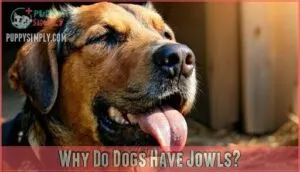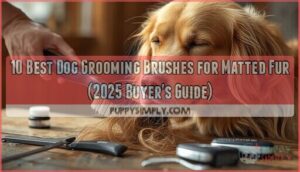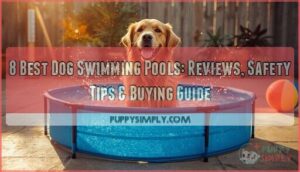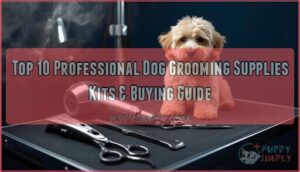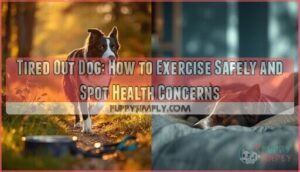This site is supported by our readers. We may earn a commission, at no cost to you, if you purchase through links.
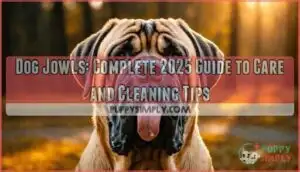
These aren’t just adorable features—they’re functional adaptations that help with eating, drinking, and scent detection.
All dogs have some degree of jowl development, though breeds like Mastiffs and Saint Bernards sport the most dramatic examples.
While jowls serve important purposes, they can trap food particles, saliva, and bacteria, creating perfect breeding grounds for infections if you don’t maintain proper hygiene.
Understanding your dog’s jowl anatomy and establishing a regular cleaning routine can prevent common issues like bacterial overgrowth, unpleasant odors, and painful skin irritation that many owners encounter.
Table Of Contents
- Key Takeaways
- What Are Dog Jowls?
- Why Do Dogs Have Jowls?
- Top 3 Products for Cleaning Dog Jowls
- How and Why to Clean Dog Jowls
- Common Issues and Maintenance for Dog Jowls
- Frequently Asked Questions (FAQs)
- Do all dogs have jowls?
- Why do dogs have jowls?
- What is a dog Jowl?
- Which dog breeds have jowls?
- Do large jowled dogs drool?
- What are dog jowls & why do dogs drool?
- Why is my dog’s mouth crusty?
- Can I use saline water to disinfect dog jowls?
- Can I use mouthwash to clean my dog’s jowls?
- Why do dog jowls smell?
- Conclusion
Key Takeaways
- Your dog’s jowls aren’t just cute—they’re functional tools that help with eating, moisture retention, protection, and scent detection, especially in breeds like Bloodhounds and Mastiffs
- You’ll need to clean those jowls regularly because trapped moisture, food particles, and bacteria create perfect breeding grounds for infections and unpleasant odors
- Watch for warning signs like redness, swelling, or foul smells that indicate lip fold dermatitis or bacterial infections requiring veterinary attention
- Use specialized pet-safe products like antimicrobial wipes or veterinarian-recommended cleansers rather than harsh soaps or human products that can irritate your dog’s sensitive skin
What Are Dog Jowls?
Dog jowls are the loose flaps of skin hanging around your pup’s mouth and cheeks.
This jowl anatomy consists of excess skin, connective tissue, and a thin fat layer that creates the characteristic droopy appearance in jowly dog breeds.
All canines possess this facial structure, but certain breeds like Bloodhounds, Bulldogs, and Mastiffs showcase more pronounced loose dog skin.
The jowl structure serves multiple functions beyond aesthetics—it’s actually brilliant canine engineering.
These skin folds allow greater mouth mobility for eating and provide natural protection during confrontations.
Understanding your dog’s jowl function helps you appreciate why some breeds sport these adorable, droopy features that require special skin health attention.
Why Do Dogs Have Jowls?
You’ve probably noticed that some dogs have droopy, hanging skin around their mouths while others have tight-fitting lips.
These loose flaps of skin, called jowls, aren’t just a cosmetic feature—they serve several important biological functions that help your dog eat, stay hydrated, and navigate their world more effectively.
They help your dog in various ways, but the text does not provide further explanation.
Makes Eating Easier
Your dog’s jowls work like expandable food pouches, allowing wide mouth opening for efficient eating.
The loose dog skin creates flexible barriers that prevent food spillage during jaw movement. These facial structures enable easy chewing by providing extra space for larger bites.
Jowly dog breeds like Mastiffs demonstrate superior food intake control, with their dog mouth structure supporting thorough mastication. The stretchy tissue facilitates food manipulation, making meals cleaner and more efficient for your pup.
Proper care of the dog’s mouth involves understanding the dog oral anatomy to prevent issues, which is crucial for maintaining your dog’s overall oral health and ensuring thorough mastication.
Helps Retain Moisture
Nature’s ingenuity shines through in how dog jowls create a sophisticated moisture control system. Those loose skin folds act like natural reservoirs, trapping saliva and water to keep your dog’s mouth properly hydrated.
Your dog’s jowls are nature’s built-in moisture management system.
This saliva retention mechanism proves especially valuable during hot weather when panting increases moisture loss. The skin folds within your dog’s jowls form pocket-like areas that store moisture during eating and drinking.
This jowl hydration system prevents food from drying out while chewing and keeps oral tissues lubricated. However, this same moisture-rich environment requires careful drool management to prevent bacterial growth.
Breeds with prominent jowls naturally drool more because excess moisture escapes these skin reservoirs. While this might seem messy, it’s actually your dog’s body maintaining ideal oral health through moisture retention.
Regular cleaning of these areas supports skin health while preserving the beneficial hydration function. Dogs with skin folds are prone to skin fold infections that require proper care and maintenance.
Offers Protection
Those protective jowls act as your dog’s natural face guard against aggressive encounters.
When another dog attempts to grab your pup’s face during play or conflict, these loose skin folds create a vital skin shield that deflects bites away from sensitive facial structures.
Nature’s brilliant design: loose jowls act as your dog’s built-in armor against facial attacks.
The extra tissue provides jaw protection by absorbing impact and preventing direct contact with delicate areas around the mouth and cheeks.
This mouth defense system proves especially valuable in breeds originally developed for protection work or hunting.
The jowls’ protective function extends beyond simple physical barriers – they distribute pressure across a larger surface area, reducing injury risk during confrontations.
While some breeds display more pronounced facial safety features than others, all dogs benefit from this built-in protective mechanism that evolution has refined over thousands of years.
Understanding dog behavior related to protective aggression triggers is essential for responsible dog ownership and preventing potential conflicts.
Keeps Water Out
Water protection through jowls functions like nature’s built-in swimming gear for your dog.
Those loose skin folds create a barrier that prevents excessive water from entering your pup’s mouth and airways during aquatic activities.
This water exclusion mechanism works especially well in breeds with prominent jowls, who’ve evolved this trait for enhanced swimming benefits.
Here’s how jowls provide jaw safety and buoyancy aid:
- Moisture retention – Jowls trap saliva, maintaining ideal mouth hydration
- Water exclusion – Loose skin forms a seal around the mouth opening
- Drowning prevention – Reduced water intake protects respiratory pathways
- Buoyancy aid – Air pockets within dog jowl moisture assist flotation
This anatomical feature proves particularly valuable for water-working breeds, where saliva retention and controlled water access mean the difference between efficient swimming and potential distress.
Regular jowl cleaning products are essential for maintaining the health and hygiene of your dog’s jowls.
Assists With Scent and Tracking
Beyond water exclusion, your dog’s jowls function as sophisticated scent-tracking equipment.
The loose skin acts like natural scent collectors, trapping odor molecules and directing them toward your pup’s olfactory system.
Dog breeds with jowls, especially Bloodhounds and Basset Hounds, excel at air scenting because their droopy flesh creates turbulence that enhances smell detection.
| Breed | Jowl Function | Scent Ability |
|---|---|---|
| Bloodhound | Collects ground scents | 230 million receptors |
| Basset Hound | Wafts odors upward | Enhanced tracking |
| Saint Bernard | Traps scent particles | Search and rescue |
| Bullmastiff | Channels airflow | Detection work |
When your dog puts their nose down for scent tracking, those floppy jowls aren’t just hanging around—they’re actively funneling smells toward the dog nose.
This anatomical advantage explains why jowled breeds dominate search-and-rescue operations and tracking competitions.
Top 3 Products for Cleaning Dog Jowls
You’ll need specialized products to maintain your dog’s jowl health and prevent bacterial infections that thrive in these moist skin folds.
These three veterinarian-recommended cleaning solutions address the unique challenges of jowl care, from antimicrobial wipes to oral health additives that reduce harmful bacteria buildup.
Petpost Bulldog Wrinkle Wipes
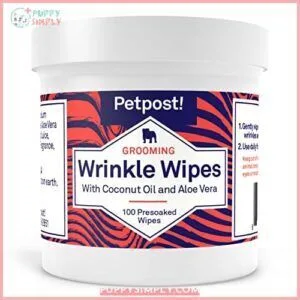
Petpost Bulldog Wrinkle Wipes offer targeted wipe effectiveness for maintaining proper jowl hygiene in dogs with prominent skin folds.
These USA-made cotton wipes contain naturally derived ingredients that gently clean canine jowls without harsh chemicals that could worsen lip fold dermatitis.
The convenient 2.7-inch size makes pet grooming easier, allowing you to reach between dog facial wrinkles where bacteria accumulate.
Regular wrinkle care with these wipes helps prevent infections common in dog skin folds while maintaining overall skin health for your pup’s comfort.
Using natural dog hygiene products, such as those found in natural care routines, can also support the health and well-being of your dog.
Oxyfresh Pet Dental Water Additive
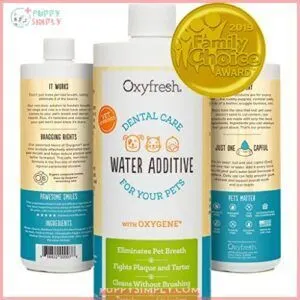
Maintaining your dog’s oral health doesn’t have to be complicated. Oxyfresh Pet Dental Water Additive offers a simple solution that transforms ordinary water into a powerful dental care tool.
This odorless, tasteless additive works behind the scenes to combat bacteria lurking in dog mouth wrinkles and skin folds around jowls. Simply add one capful to your pet’s water bowl daily, and you’ll notice fresher breath within days.
The veterinarian-recommended formula targets harmful bacteria that cause dental issues, making it particularly beneficial for breeds with prominent jowls where moisture and food particles tend to accumulate. Made in the USA with high-quality ingredients, this water additive supports overall pet hygiene without requiring any special training or cooperation from your dog.
It’s like having a dental assistant that works around the clock, ensuring your pet’s water quality contributes to better oral health.
Arf Pets Dog Cooling Mat
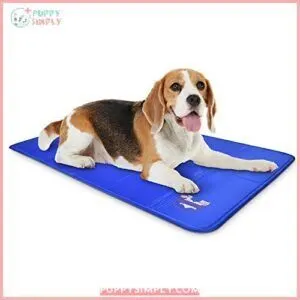
While proper oral hygiene forms the foundation of dog jowl health, controlling your pup’s environment can be equally important for preventing moisture-related issues. The Arf Pets Dog Cooling Mat offers an innovative approach to canine comfort systems that indirectly supports dog jowl health during hot weather.
This gel-based cooling mat provides up to three hours of heat relief without electricity or water. It’s designed for medium-sized dogs up to 80 pounds and works by absorbing your dog’s body heat through non-toxic materials. The mat recharges automatically after 15 minutes of non-use, making it perfect for continuous summer care.
What makes this relevant to dog facial structure health? Excessive panting in hot weather increases saliva production, which can worsen moisture problems in droopy jowls and dog mouth wrinkles. By keeping your dog cooler, you’re reducing stress-induced drooling and creating better conditions for maintaining healthy jowls.
The mat’s durability means it’ll last through multiple summers of use. Some dogs need time adjusting to the texture, but most appreciate the cooling benefits once they’re comfortable with it.
How and Why to Clean Dog Jowls
Dog jowl hygiene is more than just a beauty routine—it’s essential for preventing lip fold dermatitis and dog jowl infections. Those saggy skin folds can trap moisture and debris, creating a perfect storm for bacteria and fungi.
To keep your pup’s jowls in top shape, use Cleaning Products recommended by your vet, especially those with chlorhexidine or benzoyl peroxide. Fold Maintenance is key: spread the skin folds gently and wipe deep inside, then dry thoroughly to avoid irritation.
If your dog’s a champion drooler, Drool Management means using a towel or bib between cleanings. Don’t forget these essentials:
- Inspect jowls daily for redness or odor
- Use gentle, pet-safe wipes
- Trim excess hair for easier cleaning
- Avoid harsh soaps or alcohol-based products
Consistent Skin Hygiene keeps your dog comfortable and healthy. Regular use of natural dog products can help maintain a healthy skin barrier and prevent common issues.
Common Issues and Maintenance for Dog Jowls
Regular cleaning may prevent most problems, but dog jowls still face several common issues requiring your attention.
Jowl infections often develop when bacteria and fungi thrive in moist skin fold environments.
You’ll notice redness, swelling, and that unmistakable foul odor signaling trouble ahead.
Lip fold dermatitis affects breeds with prominent jowls most frequently.
This condition causes painful inflammation between skin folds, creating perfect breeding grounds for harmful microorganisms.
Watch for discharge, crusty scabs, or bleeding areas that indicate infection progression.
Drool management becomes challenging with larger jowls, as excessive saliva pools create ongoing moisture problems.
Dog jowl problems multiply when food particles get trapped, feeding bacterial growth within fold cleaning areas.
Establish consistent jowl hygiene routines using antimicrobial wipes or veterinarian-recommended cleansers.
Focus on fold cleaning techniques that remove debris without causing irritation.
Dog skin issues worsen when harsh chemicals damage sensitive jowl tissue.
Monitor your dog’s jowls weekly for unusual growths, particularly wart-like bumps indicating oral papillomavirus.
Dog jowl infections require professional treatment, especially when accompanied by fever or eating difficulties.
Prevention through regular maintenance saves both money and discomfort.
Regular veterinary check-ups can help identify and address common pet issues that may contribute to dog jowl problems.
Frequently Asked Questions (FAQs)
Do all dogs have jowls?
Yes, you’ll find that all dogs have jowls – those loose skin flaps around their mouths.
However, they’re only prominently visible in certain breeds like Bulldogs, Mastiffs, and Bloodhounds, while others have minimal jowl development.
Why do dogs have jowls?
Your pup’s magnificent jowls aren’t just adorable—they’re evolutionary masterpieces.
These loose skin flaps help dogs open their mouths wider for eating, retain moisture, protect their faces during scuffles, and even assist water-loving breeds with swimming buoyancy, which makes them magnificent.
What is a dog Jowl?
Your dog’s jowls are loose flaps of skin and connective tissue hanging around their mouth.
They’re functional features that help with eating, drooling control, and protection during fights or swimming activities.
Which dog breeds have jowls?
All dog breeds have jowls, but you’ll notice them most on Bloodhounds, Bulldogs, Mastiffs, Saint Bernards, Newfoundlands, Basset Hounds, Boxers, Great Danes, and Rottweilers.
These breeds sport the droopiest, most prominent jowls.
Do large jowled dogs drool?
Where there’s drool, there’s usually large jowls at play.
You’ll find that breeds with prominent jowls drool more because their loose skin creates pockets where saliva collects and overflows, making them natural slobber machines, with jowls being a key factor.
What are dog jowls & why do dogs drool?
Jowls are loose skin flaps around your dog’s mouth that help with eating, scent detection, and protection.
They’re composed of excess skin and connective tissue.
Dogs drool because jowls retain saliva naturally—larger jowls mean more drooling.
Why is my dog’s mouth crusty?
Crusty buildup around your dog’s mouth typically results from dried saliva, food particles, or bacteria accumulating in the moist folds. Regular gentle cleaning prevents infections and maintains oral health.
Can I use saline water to disinfect dog jowls?
Gentle cleansing around your pup’s facial folds requires care.
You can use sterile saline solution to clean jowls, but it’s not truly disinfecting.
Consult your vet for proper antimicrobial treatments if infection’s suspected.
Can I use mouthwash to clean my dog’s jowls?
No, don’t use human mouthwash on your dog’s jowls. It contains xylitol and alcohol that’re toxic to dogs. Instead, use veterinary-approved cleaners or plain water for safe cleaning.
Why do dog jowls smell?
Your dog’s jowls smell because trapped moisture and food particles create perfect breeding grounds for bacteria and yeast.
Those deep skin folds hold onto drool, debris, and oils, leading to funky odors that’ll make you wrinkle your nose during cuddle time, which is often a result of the moisture.
Conclusion
Surprisingly, those slobbery dog jowls that leave drool trails across your furniture actually require fastidious care to prevent serious health complications.
Regular cleaning of your dog’s jowls prevents bacterial infections, reduces odor, and maintains prime skin health.
Establishing a consistent hygiene routine using appropriate products guarantees your pet’s comfort and prevents costly veterinary interventions.
Remember that proper jowl maintenance isn’t just about cleanliness—it’s essential preventive healthcare that protects your dog’s overall well-being and quality of life.
- https://blog.tryfi.com/dog-jowls/
- https://www.reddit.com/r/DOG/comments/1c6inlq/what_are_these_on_dogs_what_are_they_for/
- https://pmc.ncbi.nlm.nih.gov/articles/PMC9944027/
- https://www.linkedin.com/pulse/9-dog-breeds-prominent-jowls-animalxorg-arymc
- https://www.dialavet.com/blog/10-dog-breeds-that-drool-the-most
